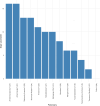Dog ecology and rabies control including canine vaccination coverage: Impacts from a survey in Madagascar
- PMID: 38722982
- PMCID: PMC11081359
- DOI: 10.1371/journal.pone.0302690
Dog ecology and rabies control including canine vaccination coverage: Impacts from a survey in Madagascar
Abstract
Background: Rabies virus (RABV; species Lyssavirus rabies) is causing one of the oldest zoonotic diseases known to mankind, leading to fatal encephalomyelitis in animals and humans. Despite the existence of safe and effective vaccines to prevent the disease, an estimated 99% of human rabies deaths worldwide are caused by dog-mediated rabies with children at the highest risk of infection. Rabies has been endemic in Madagascar for over a century, yet there has been little research evaluating local knowledge and practices impacting on the rabies control and prevention. Thus, this study was undertaken to better understand the dog ecology including canine vaccine coverage and to assess knowledge and practices of dog owners and veterinarians.
Methodology: A cross-sectional study was conducted among 123 dog-owning households in thirteen fokontanys in Mahajanga from July 4 to September 13, 2016. Single and multi-member dog-owning households in the study area on the day of the interview were eligible for inclusion and purposively selected with the support of a local guide. The survey included a household questionnaire capturing information on the dog's demographics, husbandry practices, knowledge and practices towards rabies and its control measures; the dog ecology questionnaire collected dog characteristics, vaccination status and husbandry practices. All households that reported a dog bite incident, were invited to participate in a dog bite questionnaire. In addition, direct observations of roaming dogs were conducted to assess dog population demographics and to document behavioural characteristics. Two veterinarians were purposively selected and took part in an interview during the survey period, providing information on rabies control activities, including dog-care practices in the area. Descriptive and inferential data analyses were performed using Epi Info version 7.1.5.0 (CDC Atlanta, USA).
Results: We recorded a total of 400 dogs, of which 338 (84.5%) were owned amongst 123 households. More than half (67.8%) of owned dogs were between 1 to 5 years old and 95.6% were kept for guarding purposes. 45% of the surveyed dogs had free access to roam outside the premises. The majority (85.4%) of dog owners were knowledgeable that a dog bite could potentially transmit RABV to humans. 19 dog bites were reported and of these 73.6% were caused by the owner's or a neighbour's dog. In 6 of the 19 cases, children between 7 and 15 years of age were the victims. Dog vaccination coverage against rabies was 34% among owned dogs. Of the participants aware of a veterinarian, the majority (55/82) indicated that they accessed veterinarian services at irregular intervals. The main obstacles to vaccinations cited by dog owners were limited financial resources and difficulty accessing veterinary care.
Conclusion: This study contributes to enhanced understanding of the dog ecology including canine vaccine coverage as well as knowledge and practices of dog owners in Madagascar. Most dogs in the study area were accessible for preventive vaccination through their owners, however only one third of the investigated canine population was vaccinated against rabies. Concerted national efforts towards rabies prevention and control should aim to address financial challenges and access to veterinary services.
Copyright: © 2024 Rajoromanana et al. This is an open access article distributed under the terms of the Creative Commons Attribution License, which permits unrestricted use, distribution, and reproduction in any medium, provided the original author and source are credited.
Conflict of interest statement
The authors have declared that no competing interests exist.
Figures
References
-
- Katrin B, Deborah N, Bernadette A. WHO’s latest rabies recommendations and guidance save lives and reduce the cost of treatment. One Health & Implementation Research. 2023;3(1):11–5. doi: 10.20517/ohir.2022.46 - DOI
-
- World Health O. WHO Expert Consultation on Rabies, 3rd report. Geneva.: 2018.
-
- Sudarshan MK, Madhusudana SN, Mahendra BJ, Rao NS, Ashwath Narayana DH, Abdul Rahman S, et al.. Assessing the burden of human rabies in India: results of a national multi-center epidemiological survey. International journal of infectious diseases: IJID: official publication of the International Society for Infectious Diseases. 2007;11(1):29–35. Epub 2006/05/09. doi: 10.1016/j.ijid.2005.10.007 . - DOI - PubMed
Publication types
MeSH terms
Substances
LinkOut - more resources
Full Text Sources
Medical


